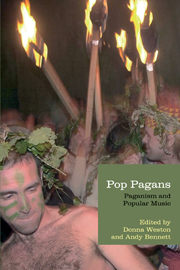Book contents
- Frontmatter
- Contents
- Contributors
- Foreword
- 1 Towards a definition of Pagan music
- Part I Histories
- Part II Genres
- Part III Performance
- Part IV Communities
- 11 Sacramental song: theological imagination in the religious music of American Pagans
- 12 The rise of the Celtic cyber-diaspora: the influence of the “New Age” on internet Pagan communities and the dissemination of “Celtic” music
- 13 Esoterrorism and the wrecking of civilization: Genesis P-Orridge and the rise of industrial Paganism
- Bibliography
- Discography and filmography
- Index
13 - Esoterrorism and the wrecking of civilization: Genesis P-Orridge and the rise of industrial Paganism
from Part IV - Communities
- Frontmatter
- Contents
- Contributors
- Foreword
- 1 Towards a definition of Pagan music
- Part I Histories
- Part II Genres
- Part III Performance
- Part IV Communities
- 11 Sacramental song: theological imagination in the religious music of American Pagans
- 12 The rise of the Celtic cyber-diaspora: the influence of the “New Age” on internet Pagan communities and the dissemination of “Celtic” music
- 13 Esoterrorism and the wrecking of civilization: Genesis P-Orridge and the rise of industrial Paganism
- Bibliography
- Discography and filmography
- Index
Summary
I always thought of Paganism as being a form of anti-establishment activity … My entire life has been about goading, prodding, and exposing the pus-filled underbelly of the established social status quo.
(Genesis Breyer P-Orridge 2001: 122)Several years ago, working with sociological ideas relating to secularization and sacralization – particularly those related to “the cultic milieu” articulated by Colin Campbell (1972) – I developed a theory about what I had begun referring to as “occulture” (Partridge 2004, 2005). I had come across the term in George McKay's excellent Senseless Acts of Beauty (McKay 1996: 51–2; see also Partridge 2004: 67–8). I was fairly sure that the term predated McKay's casual comment, but couldn't quite remember where I had heard it before. I was aware that it had begun to gain some currency within the occult community in the late 1980s. I was also aware of a small festival simply entitled “Occulture” that had been established in Brighton, England in 2000, in order – so Justin Hankinson, one of the organizers, told me – “to protect the rights and interests of people working in the esoteric domain”: When I asked Hankinson about the origin of the term, he suggested that it was most likely to have been coined by Genesis P-Orridge (Neil Andrew Megson), the founder of the experimental ritual magick network Thee Temple ov Psychick Youth (TOPY). I immediately realized that this was where I had come across it before.
- Type
- Chapter
- Information
- Pop PagansPaganism and Popular Music, pp. 189 - 212Publisher: Acumen PublishingPrint publication year: 2013

